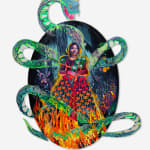Marcela Cantuária
Ângela Gomes, a rainha do Rosário, 2023
óleo sobre tela
[oil on canvas]
[oil on canvas]
211.5 x 171 x 3.5 cm (completa)
[83 1/4 x 67 3/8 x 1 3/8 in (complete)]
1.7 x 120.5 x 3.5 cm (tela)
[5/8 x 47 1/2 x 1 3/8 in (canvas)]
[83 1/4 x 67 3/8 x 1 3/8 in (complete)]
1.7 x 120.5 x 3.5 cm (tela)
[5/8 x 47 1/2 x 1 3/8 in (canvas)]
Mais imagens
Em Ângela Gomes, a rainha do Rosário, Marcela Cantuária retrata a africana Ângela Maria Gomes: capturada na região dos reinos de Uidá e Grande Popo (atual República do Benin) e...
Em Ângela Gomes, a rainha do Rosário, Marcela Cantuária retrata a africana Ângela Maria Gomes: capturada na região dos reinos de Uidá e Grande Popo (atual República do Benin) e trazida para a região de Minas Gerais como escravizada, Ângela tornou-se senhora de sua casa e conquistou sua alforria. Reconhecida como uma mulher liberta e uma das mais proeminentes participantes da Irmandade de Nossa Senhora do Rosário dos Pretos, ela manteve o vínculo com a matriz religiosa de sua terra natal sendo sacerdotisa do culto vodum, o que gerou a insatisfação da classe senhorial, sobretudo de homens brancos. As denúncias à Inquisição que a consideravam “mestra das feiticeiras” foram arquivadas em Lisboa enquanto ela continuava a sofrer a perseguição local, inclusive de alguns membros de sua própria confraria. Não obstante, Ângela resistiu enquanto liderança religiosa, celebrando as divindades voduns ao lado de outras mulheres, além de ter sido coroada rainha do Rosário dos Pretos de Itabira do Campo mais uma vez, no final de sua vida.
[In Ângela Gomes, Queen of the Rosary, Marcela Cantuária portrays the African Ângela Maria Gomes: captured in the region of the kingdoms of Uidá and Grande Popo (now the Republic of Benin) and brought to the region of Minas Gerais as a slave, Ângela became mistress of her home and won her freedom. Recognized as a freed woman and one of the most prominent members of the Brotherhood of Our Lady of the Rosary of the Black People, she maintained her ties to the religious matrix of her homeland as a priestess of the vodun cult, which caused dissatisfaction among the landlord class, especially white men. Her complaints to the Inquisition that she was a “mistress of sorceresses” were dismissed in Lisbon, while she continued to suffer local persecution, including from some members of her own brotherhood. Nevertheless, Ângela resisted as a religious leader, celebrating the vodun deities alongside other women, as well as being crowned queen of the Rosário dos Pretos de Itabira do Campo once again at the end of her life.]
[In Ângela Gomes, Queen of the Rosary, Marcela Cantuária portrays the African Ângela Maria Gomes: captured in the region of the kingdoms of Uidá and Grande Popo (now the Republic of Benin) and brought to the region of Minas Gerais as a slave, Ângela became mistress of her home and won her freedom. Recognized as a freed woman and one of the most prominent members of the Brotherhood of Our Lady of the Rosary of the Black People, she maintained her ties to the religious matrix of her homeland as a priestess of the vodun cult, which caused dissatisfaction among the landlord class, especially white men. Her complaints to the Inquisition that she was a “mistress of sorceresses” were dismissed in Lisbon, while she continued to suffer local persecution, including from some members of her own brotherhood. Nevertheless, Ângela resisted as a religious leader, celebrating the vodun deities alongside other women, as well as being crowned queen of the Rosário dos Pretos de Itabira do Campo once again at the end of her life.]







